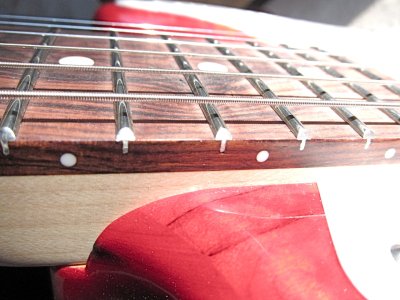On my new all-Warmoth strat, I'm having some action problems.
If I lower my action to my desired level, it buzzes quite a bit. It seems like the guitar has the appropriate amount of relief.
On the 12th fret, my action is 6/32 from wood to string on the low-E string, and 5/32 from fret to string.
On the high, it's 4/32 and 3/32, respectively.
It definitely feels higher than an "average" guitar to me.

I used this tool, pulling off the ruler to try to determine if the frets were level. I'm not sure if this is the right way to do this, but I basically layed it across three frets at a time, and checked if it would rock. It did on only the 18th fret. This would lead me to believe that this fret is considerably higher than the others.
I'm wondering if this is the cause of my issue or not.
I also attached a photo of the side of the neck. It *looks* like it may not be seated all the way, but this very well may be a "feature" of the grain.
* Is this the correct way to determine fret level-ness?
* Are my desires for lower action reasonable (it seems high to me)
* Does this fret seem to be the likely cause of my problem? I don't mind getting a fret dressing if required, but it does seem overkill to fix one fret.
* Is it possible that it's not seated correctly, and if so, can I fix it? (see photo)
Thanks again guys,
Bryce
If I lower my action to my desired level, it buzzes quite a bit. It seems like the guitar has the appropriate amount of relief.
On the 12th fret, my action is 6/32 from wood to string on the low-E string, and 5/32 from fret to string.
On the high, it's 4/32 and 3/32, respectively.
It definitely feels higher than an "average" guitar to me.

I used this tool, pulling off the ruler to try to determine if the frets were level. I'm not sure if this is the right way to do this, but I basically layed it across three frets at a time, and checked if it would rock. It did on only the 18th fret. This would lead me to believe that this fret is considerably higher than the others.
I'm wondering if this is the cause of my issue or not.
I also attached a photo of the side of the neck. It *looks* like it may not be seated all the way, but this very well may be a "feature" of the grain.
* Is this the correct way to determine fret level-ness?
* Are my desires for lower action reasonable (it seems high to me)
* Does this fret seem to be the likely cause of my problem? I don't mind getting a fret dressing if required, but it does seem overkill to fix one fret.
* Is it possible that it's not seated correctly, and if so, can I fix it? (see photo)
Thanks again guys,
Bryce



